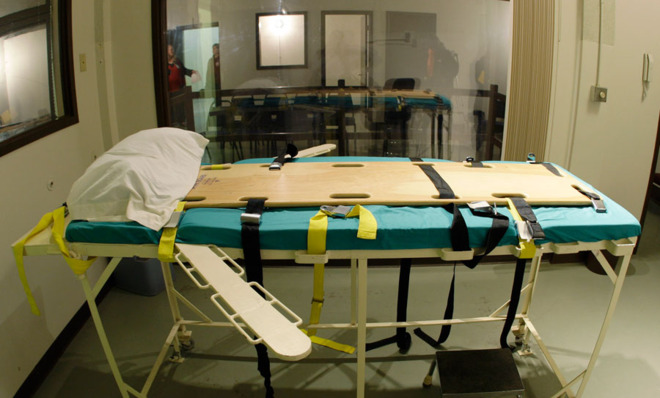The psychological trauma of witnessing an execution
Research shows that just witnessing an execution can take a serious toll


The inimitable Pamela Colloff has a story in Texas Monthly called "The Witness." It's a powerful portrait of Michelle Lyons, a woman who watched 278 executions by lethal injection over 10 years — as part of her job, first as a reporter on the prison, and then as a spokeswoman for the Texas Department of Criminal Justice. Performing this role "did not come without a cost," as Colloff illustrates.
In Lyons' first year reporting on executions for the Huntsville Item, Texas put a record 40 inmates to death. Lyons tells Colloff that always she felt a duty to be dispassionate and objective, and in the early years, this was not difficult. But as the years went on, the experience began to wear on her.
Lyons watched the executions either from a room with the inmates' family, or from a room with the family members of the inmates' victims. She felt empathy for both sides — for their grief, and for their disappointment when the closure they hoped for did not seem to come. When she started working for the TDCJ, she occasionally watched the executions from inside the room. And, when she began to allow herself to befriend some of the inmates on death row, that made the experience even harder still.
The Week
Escape your echo chamber. Get the facts behind the news, plus analysis from multiple perspectives.

Sign up for The Week's Free Newsletters
From our morning news briefing to a weekly Good News Newsletter, get the best of The Week delivered directly to your inbox.
From our morning news briefing to a weekly Good News Newsletter, get the best of The Week delivered directly to your inbox.
Lyons was and is still a supporter of capital punishment, but individual cases gave her reason to feel conflicted. "There is a difference between supporting the death penalty as a concept and being the person who actually watches its application," as she puts it. Her former boss in the communications department, who also witnessed hundreds of executions, more readily acknowledges the toll it's taken on him. He says he has nightmares, and is haunted by the memories of the people he watched die on the gurney, and by those whose names he can no longer recall.
It's not surprising that executions, even for people who support capital punishment, and even when the criminals being put to death evoke little personal sympathy because of the nature of their crimes, take a toll on witnesses. (And even executions that go smoothly, and that are not horribly botched.) It's surprising when there are people who don't seem affected by the experience in any way.
A few years ago, The New York Times profiled Houston-based reporter Michael Graczyk, who witnessed over 300 executions while reporting on court cases for The Associated Press in Texas. He has a "low-key, matter-of-fact lack of sentiment," according to The Times. Graczyk says he prefers to watch executions from the viewing room with the victim's family members in it, simply because that way he "can get out faster and file the story faster."
Perhaps Graczyk's remarkable ability to stay cool and unaffected by the process is precisely why he was kept on that beat for so long. As Cynthia Barnett has recounted in the American Journalism Review, for most reporters, covering a state-sponsored murder is not like another day at the office:
A free daily email with the biggest news stories of the day – and the best features from TheWeek.com
The challenge for journalists covering executions as news events is to put personal feelings aside. Their job is to report what they see and hear — and usually to turn it around quickly — and not focus on their own emotional reactions to the experience. But that very detachment from their feelings, Barnett explains, "may exact a psychological price."
Clinical research has backed this up. A study written up in the American Journal of Psychiatry in 1994 showed that witnessing executions could cause symptoms of dissociative disorder in journalists in the weeks following. Many people answering a survey about their experience in the San Quentin Prison said they felt anxiety and "felt estranged or detached from other people." The researchers found that the journalists displayed short-term psychological trauma on levels equal to people who had experienced another traumatic event a few years prior, the massive and fatal firestorm in Oakland and Berkeley in 1991.
Journalists on the prison beat (almost always) have to observe and report objectively about what they see. Family members of the inmates' victims, of course, have an entirely different reason for being present at an execution, and a very different experience of it. Presumably, they'll see just one execution, and they will attend in the hopes of gaining that oft-cited goal — "closure."
So do they get it? Annulla Linders, a sociologist at the University of Cincinnati, presented a paper recently at the American Sociological Association's annual meeting that explored that question. In interviews with reporters after the experience, victims' relatives sometimes express disappointment about the sterile and efficient process, or a sense of frustration over the anti-climax. "It was so quick," they might say, or "[he] should have gone through a little bit more pain."
Linders also explained how an inmate-execution doesn't just change those who witness it; the fact that it is being witnessed changes the execution process as well. There is a disconnect at play here: The policy of capital punishment is presented and carried out rationally, but society also demands an emotional release for those who have been hurt and who will watch the punishment being carried out. Over our nation's history of executions, Linders found, as the family members of victims became more a part of the process, conversations in the public debate about capital punishment shifted away from "deterrence" and more toward "retribution."
The logistics of the execution process have changed over time (for instance, including two separate viewing areas and entrances for the family members of the inmate and of the victim). But more than that, the "execution narrative" has shifted.
"No longer is it enough that the death is swift and the arrangements are efficient, the execution must now also satisfy the psychological demands of long-suffering relatives and other intimates of murder victims," Linders writes.
Even an otherwise disinterested public wants to know that those psychological demands are being met. That's why every reporter on the prison beat, when filing a story about the latest execution, has to get a quote from the family about "closure," or at least describe the faces of the family as they watched.
But what about when the public can actually watch the death itself, unmediated by press releases and newspaper reports? A study published in the journal Criminal Justice and Behavior in 1995 revealed that that, too, had an impact on how people thought about capital punishment in general. Psychologists from the University of the Pacific wanted to explore the personal and political impact of televising prisoner executions, something that has been debated for decades and fought over in court. For their study, they first gauged people's views on capital punishment, and then showed half of the group a videotape of two actual executions (the other half watched an unrelated nature video). Then they surveyed their attitudes toward capital punishment again.
The researchers found that the people who watched the executions were more likely to change their views of capital punishment, and were more likely to become less supportive of it; 57 percent of the people who watched the executions were less in favor of capital punishment than they had been before they saw them.
The authors of the study concluded that televising executions could indeed have an impact on death penalty policy. "A large majority of voters support the death penalty," they wrote. "Some of these individuals might question their support for capital punishment if they directly witnessed an execution, perhaps even enough to vote for a change."
But what still remains unknown is whether that initial impact would wear off as viewers saw more and more executions and became desensitized to them, or whether, as happened to Michelle Lyons and others, the impact of bearing witness would gradually grow over time.
Pacific Standard grapples with the nation's biggest issues by illuminating why we do what we do. For more on the science of society, sign up for its weekly email update or subscribe to its bimonthly print magazine.
More from Pacific Standard...
-
 Trump vs. states: Who gets to regulate AI?
Trump vs. states: Who gets to regulate AI?Feature Trump launched a task force to challenge state laws on artificial intelligence, but regulation of the technology is under unclear jurisdiction
-
 Decking the halls
Decking the hallsFeature Americans’ love of holiday decorations has turned Christmas from a humble affair to a sparkly spectacle.
-
 Whiskey tariffs cause major problems for American distillers
Whiskey tariffs cause major problems for American distillersIn the Spotlight Jim Beam is the latest brand to feel the pain